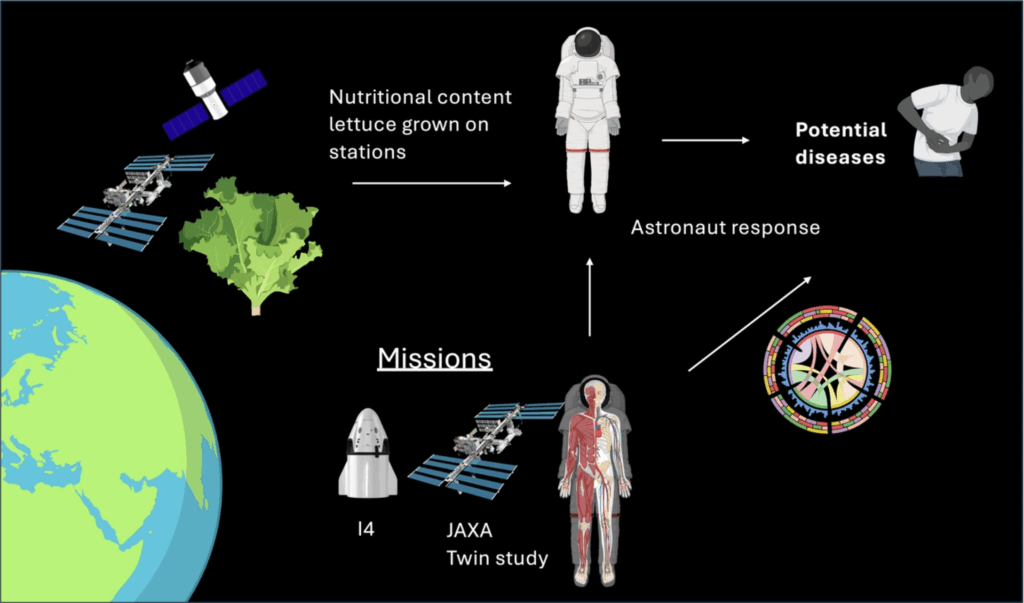
Missions to the Moon and Mars present unique nutritional challenges for astronauts, prompting a new wave of research into space-grown food. A recent study by citizen scientists has revealed significant nutritional deficiencies in lettuce grown aboard the International Space Station and China’s Tiangong II space station, highlighting the need for innovative solutions.
Volunteers from NASA’s Open Science Data Repository Analysis Working Groups (OSDR-AWG) have been diligently analyzing data on astronaut health. Their findings indicate that space-grown lettuce contains 29-31% less calcium and 25% less magnesium compared to its Earth-grown counterpart, falling short of the nutritional requirements for astronauts.
Nutritional Challenges in Space
The study uncovered two major health challenges faced by astronauts relying on space-grown vegetables. The first issue is disrupted calcium signaling, which was evidenced by changes in the expression of 163 calcium-related genes. This disruption could potentially accelerate bone loss, a significant concern for long-term space missions.
Meanwhile, data from the Japan Aerospace Exploration Agency (JAXA) revealed that astronauts experienced compromised intestinal barriers, a condition known as leaky gut syndrome. This was attributed to altered protein production and regulation, which likely affects the body’s ability to absorb essential nutrients.
Proposed Solutions: Bioengineered Crops
In response to these challenges, the researchers proposed the development of bioengineered crops. These genetically modified plants could be enriched with calcium or therapeutic proteins to compensate for the deficiencies observed in space-grown lettuce. Such innovations could play a crucial role in ensuring the health and well-being of astronauts on extended missions.
This research was a collaborative effort involving the Ames Life Sciences Data Archive (ALSDA), the Human Analysis and Plant Working Groups of the NASA Open Science Data Repository, and BioAstra, a space life science non-profit organization. The primary data source was OSDR, with additional contributions from the Space Omics and Medical Atlas at Weill Cornell.
Implications for Future Space Missions
The findings of this study underscore the importance of addressing nutritional challenges in space exploration. As missions to the Moon and Mars become more feasible, ensuring that astronauts receive adequate nutrition will be paramount. The potential for bioengineered crops to provide a viable solution is a promising development in the field of space life sciences.
According to Dr. Emily Johnson, a leading researcher in space nutrition, “The ability to grow nutrient-rich food in space is not just a convenience; it’s a necessity for the success of long-duration missions.”
“The research into bioengineered crops could revolutionize how we approach nutrition in space, providing astronauts with the essential nutrients they need to maintain their health,” Dr. Johnson added.
As space agencies and researchers continue to explore these solutions, the collaboration between citizen scientists and professional researchers will be crucial. The insights gained from this study could pave the way for more resilient food systems in space, ultimately supporting humanity’s quest to explore the cosmos.
The announcement comes as space agencies worldwide are ramping up their efforts to establish sustainable human presence beyond Earth. With the Artemis program aiming to return humans to the Moon and plans for manned missions to Mars on the horizon, addressing these nutritional challenges is more critical than ever.
The move represents a significant step forward in the realm of space exploration, where the health and safety of astronauts remain a top priority. As researchers continue to innovate and develop new solutions, the dream of living and thriving in space becomes increasingly attainable.







